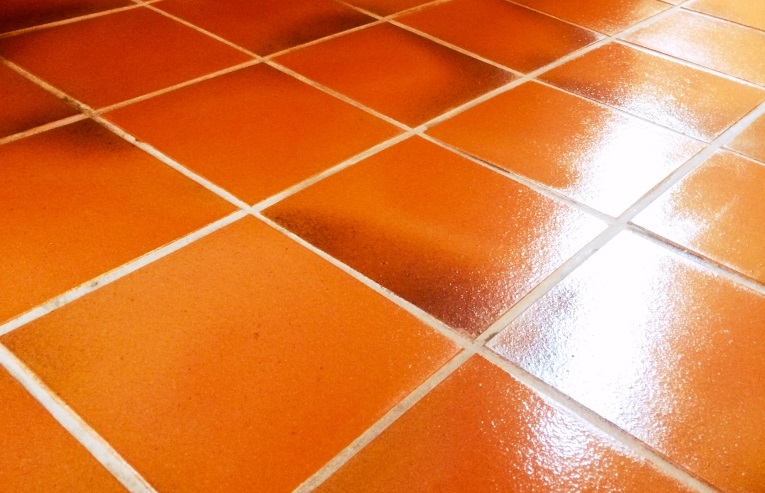Quarry tile

|
[edit] Introduction
Quarry tiles are a traditional flooring material used for both internal and external purposes. Being made of burnt clay, they are very durable, sometimes lasting many decades, with some varieties also being frost resistant. They come in a range of colours including red, brown, grey, purple and black. One of the most extensive external uses of quarry tiles in modern times was in the 1960s and 70s at the Barbican development in London.
Clay floor tiles have been used since Roman times, but fell out of favour during the Middle Ages. The most likely cause of this is that the techniques introduced by the Romans had been neglected or forgotten. However, the industrial revolution produced a revival of interest during Victorian times when alongside bricks, they were mass-produced for homes, churches and public buildings.
Today, they are considered a 'natural' material as they are made of burnt clay and used widely, particularly for hearths, conservatories and kitchens, where they can harmonise with both modern and traditional designs. As well as floors, they can also be used on walls and worktops. They are also used industrially.
Installation: Quarry tiles are usually bedded on a 10mm-thick bed of cement mortar spaced 9-10mm apart and with joints filled with cement grout. Wall junctions can be concealed with a cove tile for easier cleaning, while a range of special bullnose-edged tiles can be used for terminations, edges etc.
[edit] Manufacture
Quarry tiles are made in a process similar to that of brick, from either extruded or press-formed clay which is kiln-fired at temperatures as high as 2,000ºC. Their dimensions may vary but typically they are 150mm x 150mm (although larger sizes are available) and 13 to 19mm thick. They are unglazed and give good grip underfoot but can also be embedded with an abrasive frit to provide a non-slip finish for applications such as commercial kitchens and laboratories.
Because quarry tiles can be in place for decades, they may require a degree of renovation to restore them to an ‘almost new’ appearance. Cracked and missing tiles can be a problem but can usually be sourced to provide colour shades that are a close match with the original.
Dirty or faded tiles can be restored with alkaline cleaning compounds applied with a rotary floor machine, then rinsed off. A final clean may be applied with a light acid to remove any signs of efflorescence and counter the alkaline cleaner used in the first step. A matt sealing finish can then be applied. The advice of specialists should be sought when renovating quarry tiles.
[edit] Related articles on Designing Buildings Wiki
- Ash or oak wood flooring.
- Beam and block.
- BREEAM Speculative floor & ceiling finishes.
- Domestic floors: Part 1: Construction, insulation and damp proofing.
- Floating floor.
- Floor definition.
- Floor insulation.
- Flooring defects.
- Glass block flooring.
- How to fit carpet.
- Insulation for ground floors.
- Mastic sealant.
- Raised floor.
- Resin flooring.
- Screed.
- Sprung floor.
- Terrazzo.
- Tiles.
- Types of carpet.
- Types of floor.
Featured articles and news
Government consultations for the summer of 2025
A year of Labour, past and present consultations on the environment, the built environment, training and tax.
CMA competitiveness probe of major housing developers
100 million affordable housing contributions committed with further consultation published.
Homes England supports Greencore Homes
42 new build affordable sustainable homes in Oxfordshire.
Zero carbon social housing: unlocking brownfield potential
Seven ZEDpod strategies for brownfield housing success.
CIOB report; a blueprint for SDGs and the built environment
Pairing the Sustainable Development Goals with projects.
Types, tests, standards and fires relating to external cladding
Brief descriptions with an extensive list of fires for review.
Latest Build UK Building Safety Regime explainer published
Key elements in one short, now updated document.
UKGBC launch the UK Climate Resilience Roadmap
First guidance of its kind on direct climate impacts for the built environment and how it can adapt.
CLC Health, Safety and Wellbeing Strategy 2025
Launched by the Minister for Industry to look at fatalities on site, improving mental health and other issues.
One of the most impressive Victorian architects. Book review.
Common Assessment Standard now with building safety
New CAS update now includes mandatory building safety questions.
RTPI leader to become new CIOB Chief Executive Officer
Dr Victoria Hills MRTPI, FICE to take over after Caroline Gumble’s departure.
Social and affordable housing, a long term plan for delivery
The “Delivering a Decade of Renewal for Social and Affordable Housing” strategy sets out future path.
A change to adoptive architecture
Effects of global weather warming on architectural detailing, material choice and human interaction.
The proposed publicly owned and backed subsidiary of Homes England, to facilitate new homes.
How big is the problem and what can we do to mitigate the effects?
Overheating guidance and tools for building designers
A number of cool guides to help with the heat.
The UK's Modern Industrial Strategy: A 10 year plan
Previous consultation criticism, current key elements and general support with some persisting reservations.
Building Safety Regulator reforms
New roles, new staff and a new fast track service pave the way for a single construction regulator.
























